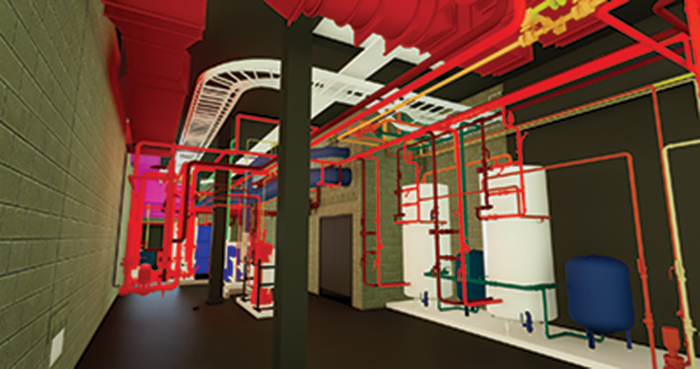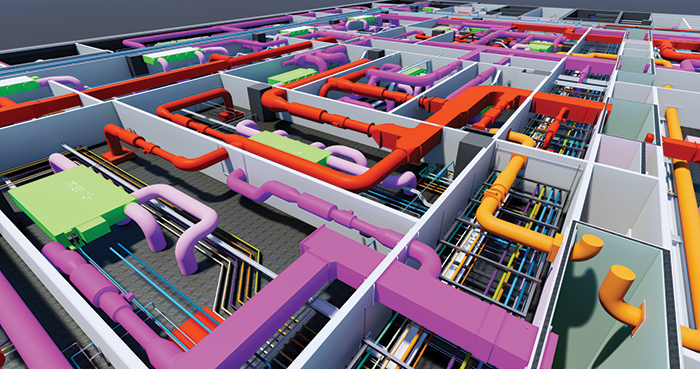Mechanical, electrical and plumbing (MEP) installations in cleanroom laboratory and manufacturing facilities demand highly complex and technical solutions to meet the stringent requirements of the industry. Gavin Dunstan, digital engineering operations director at SES, recognises that to build a facility that meets these demands, as well as providing the flexibility for the majority of the research space to have a multitude of uses, means engineers must raise the bar even further. “Throw into the ring the usual fast track pre-construction period and a full BIM Level 2 requirement and the scale of the exciting challenge facing companies like us is clear,” he says. As with all cleanroom projects, an overriding consideration for success is the necessity for zero-failure design and faultless accuracy, especially within high containment environments.
Challenges are, of course, there to be overcome, and that is what SES has reportedly achieved on recent laboratory projects in the UK, including the Centre for Process Innovation (CPI) in Darlington and The Pirbright Institute in Surrey. In addition, SES is currently delivering solutions to The Quadram Institute in Norwich and Project Capella in Cambridge.
Dunstan explains: “One of the key secrets to this success is close collaboration and a mutual understanding between science professionals, operations managers and built environment specialists. Each and every design and installation has a unique purpose and, therefore, requires bespoke specification balanced against the flexibility demanded by the science and research sector.”
Dunstan also points out that it is increasingly important that all project partners, from funding bodies and scientists to operations managers, engineering and design consultants, share responsibility for ensuring every decision is taken in the best interests of science.
Play as a team
Furniture, fixtures and equipment (FF&E) is always a major element of any high-tech project. Operations managers and teams will always have specialist equipment, which is either new, or being transferred into a new facility. The final part of the design is information released by the customer, often morphing at various stages through the design process.
“BIM gives the opportunity to coordinate this in real time at the earliest stage, not only with building fabric but also the essential services to support the equipment,” says Dunstan, adding that careful and detailed coordination with the end-user’s operations manager and team is required to ensure FF&E items are useable, maintainable and of course replaceable if necessary. This is all part of the essential design interface with the BIM model.
Close attention should also be given, he says, to the schedules of specialist equipment while viewing the FF&E layouts, as the airflow and pressure surrounding many appliances is often critical to their successful operation.
My advice on a possible pitfall: agree fixed FF&E as early as possible, but engineers shouldn’t be surprised or downhearted when this changes!”
According to Dunstan, developing a quality BIM model and using defined products gives engineers the opportunity to extract data for accurate costing in the early stages of the pre-construction period. It also provides an audit trail to track the changes as the design develops or the scope changes through further engagement workshops.
“More laboratories are becoming BIM Level 2 projects and the data deliverables can be very time-consuming,” he says. “It is vital for both engineers and operations managers to always ensure that the correct level of data supply is obtained and agreed at the early stages.
Maintenance and engagement strategy

Detailed plantroom modelling ensures that plant is simply installed, easily maintainable and the appropriate space is reserved for future client or specialist fit outs
One of the most advantageous uses of the BIM model is the possibility to virtually review the new facility at the very earliest of pre-construction stages.
From this, engineers can establish a systems and plant access and replacement strategy with the operations manager and FM or maintenance teams. Dunstan says these teams have experience of the day-to-day management of the facilities and their input is an absolute necessity.
Initial stakeholder involvement also offers the opportunity to engage with a broad demographic of interested parties at early design stages to review the new facility, its operation and coordination where people and material flows can be discussed in detail before construction. “Early collaboration is essential. However, be prepared for changes later on in the project,” Dunstan explains, adding that understanding the needs of the user and the space they operate is a prerequisite and can only be achieved by engineers asking the right questions that result in producing room data sheets collating their highly-detailed requirements.
Most laboratories, for example, will require a greater number of air changes due to cleanliness requirements, dissipation of high heat gains or dilution of potentially hazardous gases; in some cases, a lab might require all three. Laboratories will usually be operated at a positive or negative pressure either to maintain room/process cleanliness or protect the environment respectively. “Establishing the client’s standard operating procedures (SOPs) early in the design ensures the designer understands the room’s usage and scientific objectives and best to make life easier for the user,” Dunstan says.
Offsite manufacturing

Multi-service prefabricated modules ensure that the services distribution on each level is contained within the corridors
The production of a design using defined data aids the offsite strategy, it assists with the early development to maximise the offsite opportunity, which realises the full potential of the strategy for the construction programme as well as the site/labour benefits. To meet with both the spatial and programme restrictions, SES has relied upon a high level of services prefabrication, which includes risers, multi-service modules, plant skids and even offsite produced brackets for areas where prefabrication may not be feasible. The BIM team at SES makes sure the company can prefabricate and produce stage 4C installation drawings or stage 5 manufacturing drawings by supplementing the models during usage of the SysQue extension for REVIT. Dunstan explains: “This product, in which SES has heavily invested, allows the REVIT model to be populated with true to life-sized pipework and fittings.”
According to Dunstan, this not only increases the critical accuracy of the services coordination, but also allows the use of the company’s BIM2MOSAIC procedure, which auto-generates material take-offs direct from the coordinated model.
In addition, SES has used BIM to ‘walk’ client maintenance staff around complex plant spaces at the design stage. This is an innovation that, Dunstan argues, ensures the client is given a unique insight into how the completed project will function and ensures their expectations are managed effectively throughout the process.
Data security
Security is a very real issue for BIM and for all stakeholders. The act of collating all of the building information within one distinct digital file is, for many projects within this sector, a major issue and possibly elevates a project to much higher security levels than would have happened traditionally.
In the UK, the government has taken action in this field and made plans for information security during the recent BIM Level 2 specifications with the publishing of the PAS 1192-5-2015 guidance. Dunstan points out, however, that while there are still many holes to be filled, after working in line with this document, there is guidance available when it is needed.
A possible pitfall to look out for, Dunstan says, is checking the security level from the beginning. “Ensure information is shared in a security-minded fashion; no-one should waste time with detailed COBie asset data if this is a security-conscious project,” he explains.
The final and probably the most common challenge within laboratories and all controlled environments, is the general coordination. Space, Dunstan says, is very much a premium in these types of buildings and the high complexity of services will always make the overall coordination far more of a challenge than in most other sectors.
Dunstan believes that through early engagement the staff can work in a multi-disciplined way with the designers to optimise building volume and spatial fit, and with operations managers to ensure the cleanroom environment meets every need of the modern scientist.
Whilst many of these types of projects are often not full design and build, companies invariably have significant stage 4B/4C design obligations and for manifold reasons, they often need to incorporate several major adjustments to complete the construction design.
“As a specialist contractor in this sector, SES is aware that this is nothing unusual and something we must grab by the horns to offer a quality, final product to our customer and their operations teams, in the best interests of science,” Dunstan concludes.




